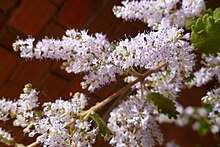
Back Lamiaceae Afrikaans شفوية Arabic شفويه ARZ Lamiaceae AST Dalamazkimilər Azerbaijani Һаңғырау кесерткән һымаҡтар Bashkir Lamiaceae BCL Ясноткавыя Byelorussian Ясноткавыя BE-X-OLD Lamiaceae Bulgarian
| Lamiaceae | |
|---|---|

| |
| Lamium purpureum L. | |
| Scientific classification | |
| Kingdom: | Plantae |
| Clade: | Tracheophytes |
| Clade: | Angiosperms |
| Clade: | Eudicots |
| Clade: | Asterids |
| Order: | Lamiales |
| Family: | Lamiaceae Martinov[1][2] |
| Type genus | |
| Lamium | |
| Genera | |


The Lamiaceae (/ˌleɪmiˈeɪsiː.iː, -i.aɪ/ LAY-mee-AY-see-ee, -eye)[3] or Labiatae are a family of flowering plants commonly known as the mint, deadnettle or sage family. Many of the plants are aromatic in all parts and include widely used culinary herbs like basil, mint, rosemary, sage, savory, marjoram, oregano, hyssop, thyme, lavender, and perilla, as well as other medicinal herbs such as catnip, salvia, bee balm, wild dagga, and oriental motherwort. Some species are shrubs, trees (such as teak), or, rarely, vines. Many members of the family are widely cultivated, not only for their aromatic qualities, but also their ease of cultivation, since they are readily propagated by stem cuttings.[citation needed] Besides those grown for their edible leaves, some are grown for decorative foliage. Others are grown for seed, such as Salvia hispanica (chia), or for their edible tubers, such as Plectranthus edulis, Plectranthus esculentus, Plectranthus rotundifolius, and Stachys affinis (Chinese artichoke). Many are also grown ornamentally, notably coleus, Plectranthus, and many Salvia species and hybrids.
The family has a cosmopolitan distribution.[4] The enlarged Lamiaceae contain about 236 genera[5] and have been stated to contain 6,900[4] to 7,200[5] species, but the World Checklist lists 7,534.[6] The largest genera are Salvia (900), Scutellaria (360), Stachys (300), Plectranthus (300), Hyptis (280), Teucrium (250), Vitex (250), Thymus (220), and Nepeta (200).[5] Clerodendrum was once a genus of over 400 species,[5] but by 2010, it had been narrowed to about 150.[7]
The family has traditionally been considered closely related to the Verbenaceae;[5] in the 1990s, phylogenetic studies suggested that many genera classified in the Verbenaceae should be classified in the Lamiaceae [8][9] or to other families in the order Lamiales.[1]

The alternative family name Labiatae refers to the flowers typically having petals fused into an upper lip and a lower lip (labia in Latin). The flowers are bilaterally symmetrical with five united petals and five united sepals. They are usually bisexual and verticillastrate (a flower cluster that looks like a whorl of flowers, but actually consists of two crowded clusters). Although this is still considered an acceptable alternative name, most botanists now use the name Lamiaceae in referring to this family. The leaves emerge oppositely, each pair at right angles to the previous one (decussate) or whorled. The stems are frequently square in cross section,[10] but this is not found in all members of the family, and is sometimes found in other plant families.
- ^ a b Stevens, P. F. (July 2012). "Lamiales (Lamiaceae Family)". Angiosperm Phylogeny Website. Archived from the original on 21 March 2015. Retrieved 25 March 2015.
- ^ Angiosperm Phylogeny Group (2009). "An update of the Angiosperm Phylogeny Group classification for the orders and families of flowering plants: APG III". Botanical Journal of the Linnean Society. 161 (2): 105–121. doi:10.1111/j.1095-8339.2009.00996.x. hdl:10654/18083.
- ^ "Pronunciation of lamiaceae". Archived from the original on 2015-09-24. Retrieved 2014-11-25.
- ^ a b Heywood, Vernon H.; Brummitt, Richard K.; Seberg, Ole; Culham, Alastair (2007). Flowering Plant Families of the World. Ontario, Canada: Firefly Books. ISBN 978-1-55407-206-4.
- ^ a b c d e Raymond M. Harley, Sandy Atkins, Andrey L. Budantsev, Philip D. Cantino, Barry J. Conn, Renée J. Grayer, Madeline M. Harley, Rogier P.J. de Kok, Tatyana V. Krestovskaja, Ramón Morales, Alan J. Paton, and P. Olof Ryding. 2004. "Labiatae" pages 167-275. In: Klaus Kubitzki (editor) and Joachim W. Kadereit (volume editor). The Families and Genera of Vascular Plants volume VII. Springer-Verlag: Berlin; Heidelberg, Germany. ISBN 978-3-540-40593-1
- ^ "World Checklist of Selected Plant Families". Archived from the original on 2017-07-09. Retrieved 2022-02-21.
- ^ Yuan, Yao-Wu; Mabberley, David J.; Steane, Dorothy A.; Olmstead, Richard G. (2010). "Further disintegration and redefinition of Clerodendrum (Lamiaceae): Implications for the understanding of the evolution of an intriguing breeding strategy". Taxon. 59 (1): 125–133. doi:10.1002/tax.591013.
- ^ Cantino, P.D., Harley, R.M. & Wagstaff, S.J. 1992. Genera of Labiatae: status and classification. Pp. 511-522. In: Raymond M. Harley and Tom Reynolds (editors). Advances in Labiate Science. Richmond, Royal Botanic Gardens, Kew.
- ^ Wagstaff, Steven J.; Hickerson, Laura; Spangler, Russ; Reeves, Patrick A.; Olmstead, Richard G. (1998). "Phylogeny in Labiatae s.l., inferred from cpDNA sequences". Plant Systematics and Evolution. 209 (3–4): 265–274. doi:10.1007/bf00985232. S2CID 601658.
- ^ Parnell, J. and Curtis, T. 2012. Webb's An Irish Flora. Cork University Press ISBN 978-185918-4783
© MMXXIII Rich X Search. We shall prevail. All rights reserved. Rich X Search